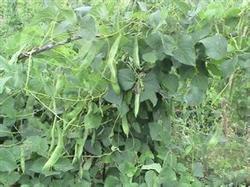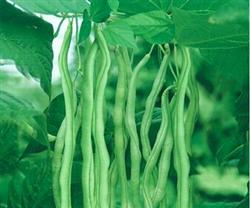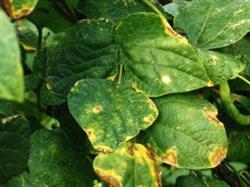Control of main Diseases and insect pests of Kidney Bean

See the symptoms of melon white silk disease: dark brown at the base of the stem, dense white filamentous mycelium on the surface, and tea-brown round sclerotia on the mycelium in the later stage. Disease regularity and control methods: refer to the distribution of Sclerotinia sclerotiorum disease of melon and host plant: it is distributed all over the country. In addition to harming beans, it also infects other vegetables. Symptoms: the stem base or vine near the ground is immersed at first, and then grayish white. In the moist environment, the disease stem is dense with white cotton-like mycelium and black sclerotia. Disease regularity: overwintering in sclerotia in the soil. The descendants of ascospores were infected for the first time with airflow. During the growth period of vegetable plants, the re-infection was mainly carried out by the mutual contact of mycelium. The temperature is about 20 ℃ and the relative humidity is more than 85% is beneficial to the occurrence of the virus. Prevention and control methods: (1) rotation. (2) strengthen field management and rational fertilization and irrigation. (3) spraying in time, 50% topazine wettable powder or 52% carbendazim wettable powder 1000 times, once every 7-10 days, a total of 2-3 times. The distribution of bean bacterial blight and host plants occurred in northeast provinces, Henan, Hubei, Hunan, Jiangsu, Zhejiang and other provinces. Harm to kidney beans, but also against mung beans, adzuki beans, cowpeas and lentils. Symptoms: the primary dark green water-immersed spots on the leaves are irregular and brown after enlargement, the diseased tissue becomes thin and translucent, and there is a yellow halo around it. Old disease spots are prone to rupture. The young leaves are deformed, and when they are serious, the diseased leaves shrink and fall off. The symptoms of stems and pods are similar to those of leaves, showing water-immersed spots at first, stripes (on stems) and round or irregular spots (on pods), respectively, sunken and reddish brown after expansion. There is often a yellowish bacterial pus on the spot surface, and there are yellow spots on the infected part of the seeds of the diseased pods or only slightly macular spots on the navel. The law of disease: the pathogen stayed on the ground in the seeds and the remains with the disease to survive the winter. After the seeds with bacteria germinated, the cotyledons became ill successively, and the pathogenic bacteria were produced in the cotyledons, which were transmitted to the bean plant through wind and rain, insects, humans and animals, and invaded from the stomata. High temperature and high humidity were suitable for the epidemic of the disease, but the disease stopped gradually at 36 ℃. The incubation period at high temperature is usually 2-3 days. Control methods: (1) choose disease-free seeds to sow. (2) rotation with non-legume crops for two years. (3) spray 0.5% Bordeaux solution, once every 7-10 days, a total of 2-3 times. The distribution of Braised Tofu with Vegetables leaf disease and host plants: it is distributed all over the country. There are three kinds of viruses that cause Braised Tofu with Vegetables's leaf disease: bean common mosaic virus not only harms kidney beans, but also some bean plants, broad beans, cowpeas and lentils. Bean yellow mosaic virus includes not only the host plants of bean common mosaic virus, but also peas, soybeans, two kinds of clover, white fan lentils, white sweet clover, black alfalfa, Tangjingpu and so on. The bean strain of cucumber mosaic virus only harms bean. Symptoms: the young leaves show bright veins, lack of green or wrinkled hard at the beginning, the new young leaves are flowers and leaves, and their green parts protrude or concave in the shape of a bag, and some varieties become deformed after being infected. The diseased plants are dwarf or normal, and the pods are generally normal. The symptoms caused by bean yellow mosaic virus are more serious than those caused by other strains, the color of flowers and leaves are yellow, and the downward curvature of leaves is also more serious. Disease regularity: the main source of primary infection is the overwintering host plant, in addition to bean yellow mosaic virus, the infected seeds of the other two viruses are also the main sources of primary infection. During the growth period, it is mainly transmitted by aphids. It takes about 1-5 minutes for aphids to absorb the virus on diseased plants and to transmit indoor virus on healthy plants, but the shortest time for yellow mosaic of kidney beans is 15 seconds and 15-30 seconds, respectively. Most of them showed heavy mosaic, dwarf and curled leaves at high temperature (26 ℃), light mosaic at about 18 ℃, symptoms above 28 ℃ and below 18 ℃ were inhibited, and strong light and prolonged light time tended to aggravate the symptoms. Control methods: (1) breeding disease-resistant varieties. (2) the disease-free plants remain seeds. (3) timely control of aphids.
- Prev

High-yield cultivation techniques of kidney bean
Kidney beans are native to Mexico and America, and have spread all over the world since the 17th century. They are also known as flowered kidney beans. Cultivation has a long history, due to the large export volume, the area is expanding year by year. It is nutritious, the protein content is high, namely the vegetable is the grain, but also can make the cake and the bean filling, is the export earns the foreign exchange.
- Next

Greenhouse tomato with kidney bean
Symptoms: the disease can occur from seedling stage to adult stage, mainly harming leaves, stems, pods and seeds. The cotyledons of the diseased seedlings showed a reddish-brown ulcerated shape, and the disease spot at the base of the stem surrounded the stem for a week, showing a reddish-brown ulcerated shape, which made the seedlings break and die. Prevention and control methods: 1. Implement crop rotation for more than 3 years. 2. Never a disease-free field.
Related
- The first cup of black tea in spring, the flavor and history of tea gardens in Kenya, Africa
- The computer can not only choose potatoes, but also grow tea rice. AI will grow winter oolong tea champion.
- It is not only the inflated tea bitten by insects, but also engraved with the four seasons tea in Beipu.
- The Oriental Beauty Tea Festival in Zhuxian County takes the stage at the weekend to experience the plus-size feast of oil tea.
- & quot; Oriental Beauty Tea & Exploration of Emei in Hsinchu, the hometown of quot;
- The new variety of strawberry "Tainong 1" dessert is the first choice with mellow aroma. Crimson gorgeous
- History of Tea in Taiwan: from Wild Inner Mountain to Export Tea Garden
- Two types of Taiwan Oriental Beauty Black Tea won the British three-Star Award for Childhood Tea Xiang Zhang Jiaqi changed from pilot to champion tea maker.
- Banana species and varieties: the planting history of Taiwan Xianren banana and dwarf banana is long, is banana disease resistant?
- Coffee planting Technology: Qianjie Coffee from Seedling to harvesting

